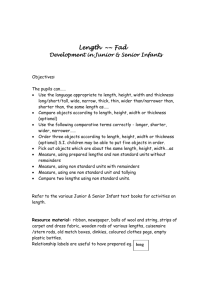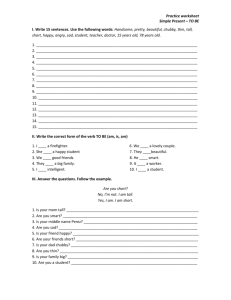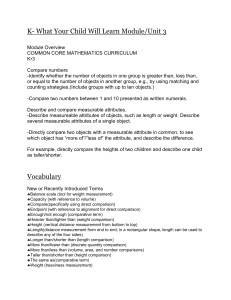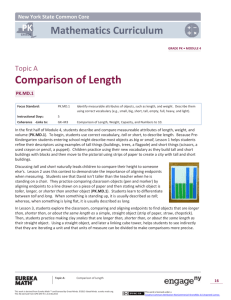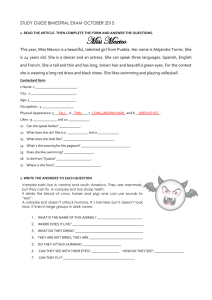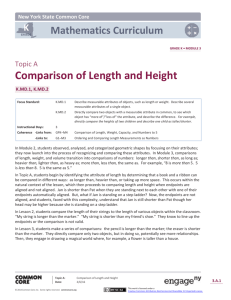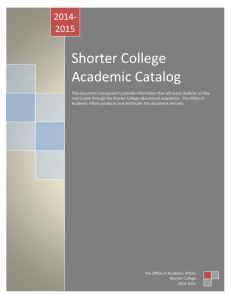es_ma_measure_length
advertisement
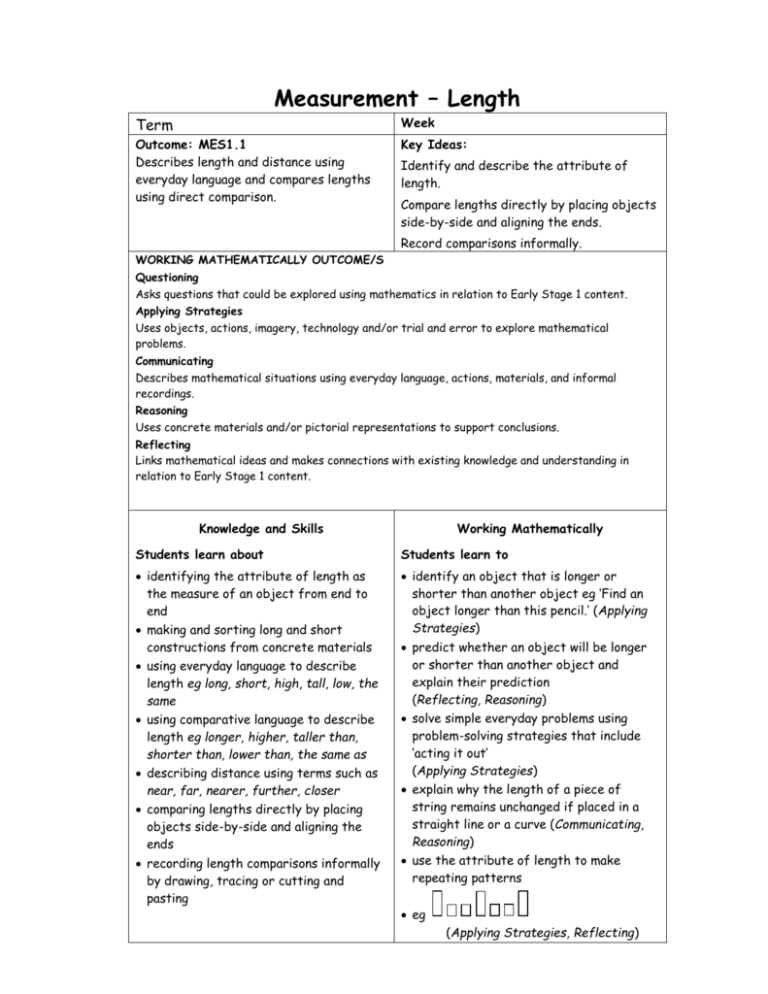
Measurement – Length Term Week Outcome: MES1.1 Describes length and distance using everyday language and compares lengths using direct comparison. Key Ideas: Identify and describe the attribute of length. Compare lengths directly by placing objects side-by-side and aligning the ends. Record comparisons informally. WORKING MATHEMATICALLY OUTCOME/S Questioning Asks questions that could be explored using mathematics in relation to Early Stage 1 content. Applying Strategies Uses objects, actions, imagery, technology and/or trial and error to explore mathematical problems. Communicating Describes mathematical situations using everyday language, actions, materials, and informal recordings. Reasoning Uses concrete materials and/or pictorial representations to support conclusions. Reflecting Links mathematical ideas and makes connections with existing knowledge and understanding in relation to Early Stage 1 content. Knowledge and Skills Working Mathematically Students learn about Students learn to identifying the attribute of length as the measure of an object from end to end identify an object that is longer or shorter than another object eg ‘Find an object longer than this pencil.’ (Applying Strategies) making and sorting long and short constructions from concrete materials using everyday language to describe length eg long, short, high, tall, low, the same using comparative language to describe length eg longer, higher, taller than, shorter than, lower than, the same as describing distance using terms such as near, far, nearer, further, closer comparing lengths directly by placing objects side-by-side and aligning the ends recording length comparisons informally by drawing, tracing or cutting and pasting predict whether an object will be longer or shorter than another object and explain their prediction (Reflecting, Reasoning) solve simple everyday problems using problem-solving strategies that include ‘acting it out’ (Applying Strategies) explain why the length of a piece of string remains unchanged if placed in a straight line or a curve (Communicating, Reasoning) use the attribute of length to make repeating patterns eg (Applying Strategies, Reflecting) LEARNING ACTIVITIES LEARNING ACTIVITIES BUILDING COMPARING Provide students with a variety of materials, e.g. sticks, straws, leaves, Lego or Duplo blocks and allow them to construct and arrange. Look for and talk about objects that are longer, shorter, taller, wider, near and far in the classroom and outside. TIE, CUT AND DRAW STARTING POINT • Cut a length of string into shorter pieces. • Tie pieces of skipping rope together to make one length. • Unroll the garden hose, rope, ball of string, extension cord, etc to investigate its length. Discuss whether the length changes when it is unrolled. • Draw a long line, short line, long straight line, short curved line, etc. • Use a painting/drawing program to “draw” thick, thin, long, straight, curved lines on a computer screen. SORTING AND NAMING Compare the heights of two students when both are standing on the floor and when one is standing on a chair. Discuss this comparison. Have a group of students arrange themselves for the start of a race. Discuss whether or not they have organised a “fair start”. Cut a streamer the same length as a desk. Check to make sure the streamer extends from one end to the other along the edge of the desk. Compare other desks. Repeat for the width of the desks. • Have students take turns in sorting objects into categories. Ensure that a sorting into the categories “long” and “short” occurs. • Name and describe objects that are deep, high, long, thin, etc in the playground, classroom and home. Name and describe tall, short, etc objects in pictures, photographs and magazines. GUESS AND CHECK GAMES Blindfold students, place two objects into their hands and ask questions such as “What is each object?” and “Which one is longer or shorter, thicker or thinner?” Play guessing games. “I am a tall animal with a long neck. What am I?” “I spy with my little eye something near the door that is short and thin.” Games like Hopscotch, Cat and Mouse, Drop the Hanky and Punchinello helps the student to develop language related to perimeter and area. STORIES Read stories about long and short people and animals. Encourage students to make up their own stories which they can combine into class books. INCIDENTAL ACTIVITIES Use opportunities that arise during the day to describe objects as being short, tall, fat, long, thin, thick, high, low, near and far. • On an excursion say, “Let’s walk to the tall tree.” • After a story asks, “What did the witch look like?” • During a game ask students to throw a ball high. • Ask students to take three short steps when dancing. • Discuss the location of rooms in the school in terms of whether they are near to or far from the classroom. Estimate, which is the longer, a shoe or a pen. Check by placing the pen alongside the shoe. SIDE BY SIDE Compare directly the length or height of two objects by placing them side-by-side. State which object is longer or taller? BLINDFOLD FRIENDS AND FAMILY Find a friend taller than you. Find another friend shorter than you. “Is there anyone about the same height?” Show results in a drawing. Repeat the activity using family members. LENGTH HUNT Find objects which are - taller than this stick - deeper than this plant pot - not as long as your pencil - shorter than your little finger - about the same length as your eraser - as narrow as a straw - as thin as a finger - as thick as a dictionary - as wide as a newspaper. Make a class/group book about these findings. A word processor and drawing program can be used to publish a class book about students’ findings. RIBBON LENGTH Give students different lengths of ribbon. They must find objects that are about the same length by placing the ribbon directly on the object. Repeat for objects that are longer or shorter than the ribbon. Resources Sticks, straws, wood off-cuts, ribbons, streamers, cardboard, string, dowel sticks, rods, Lego bricks, Duplo bricks, Unifix, drawing/painting software, a word processor. Links English (Talking and Listening) – Talks about oral texts using words such as beginning, middle, end; talks and listens to others in small-group and whole-class discussions; participates in partner and small group activities; responds to simple questions. English (Reading) – Demonstrates emerging awareness of symbols and conventions when making meaning from texts. English (Writing) – Experiments with and practises ways of representing ideas and information using written and visual symbols. Science and Technology – Uses everyday and comparative language to describe the length of living things. PDHPE – Measures and compares length directly during locomotor activities. Technology Language tall, taller, short, shorter, long, longer, deep, wide, wider, thick, thicker, thin, thinner, fat, fatter, straight, straighter, curved, high, close, near, far, low, lower, high, higher, about the same, as tall as, not as tall as, length, distance, as long as, not as long as, height, nearer, further, closer, nearer than, closer to, closer than, further from Concepts such as big, tall, long and high are often confused by young students. Activities that help students differentiate between these may be incidental or planned and will need to be done over a period of time. Assessment Ask students to • compare lengths from the same starting point, e.g. students choose two streamers of different lengths and paste them onto a sheet of paper • describe objects as being shorter, longer, wider, deeper, thicker or thinner than another object • compare directly the lengths of two objects, eg by laying one piece of paper on top of another to see which is wider, narrower or longer. Observe whether students use the same starting point. Evaluation • Did students discuss their work? • Did I allow sufficient time to complete the activities?
